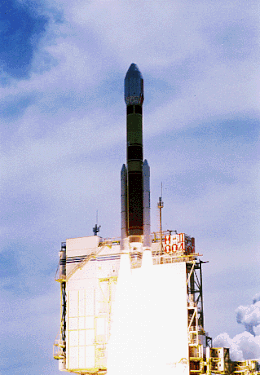H-II
| H-II | ||
|---|---|---|
 El H-II lanzando el satélite de observación terrestre ADEOS
| ||
| Características | ||
| Funcionalidad | Lanzadera espacial | |
| Fabricante | Mitsubishi Heavy Industries | |
| País de origen |
| |
| Coste por lanzamiento | (2024) | |
| Medidas | ||
| Altura | 49 m | |
| Diámetro | 4 m | |
| Masa | 260.000 kg | |
| Etapas | 2 | |
| Capacidades | ||
| Carga útil a OTB | 10.060 kg | |
| Carga útil a GTO | 3.930 kg | |
| Historial de lanzamiento | ||
| Estado | Retirado | |
| Lugar de lanzamiento | LC-Y, Tanegashima | |
| Totales | 7 | |
| Con éxito | 5 | |
| Fracasos | 1 | |
| Fracasos parciales | 1 | |
| Vuelo inaugural | 3 de febrero de 1994 | |
| Último vuelo | 15 de noviembre de 1999 | |
| Propulsores | ||
| Nº de Propulsores | 2 | |
| Motores | 1 | |
| Empuje | 1.539,997 kN | |
| Impulso específico | 273 s | |
| Tiempo de quemado | 94 segundos | |
| Propelente | Sólido | |
| Primera etapa | ||
| Motores | 1 LE-7 | |
| Empuje | 1.077,996 kN | |
| Impulso específico | 446 s | |
| Tiempo de quemado | 346 segundos | |
| Propelente | LOX/LH2 | |
| Segunda etapa | ||
| Motores | 1 LE-5A | |
| Empuje | 121.5 kN | |
| Impulso específico | 452 s | |
| Tiempo de quemado | 600 segundos | |
| Propelente | LOX/LH2 | |
El H-II fue el primer cohete pesado japonés desarrollado enteramente con tecnología nacional. Sus antecesores, el lanzador N-1 y el H-I, habían usado tecnología estadounidense, y el Mu-V se considera un cohete para cargas pequeñas.
El programa se inició en 1984 y el primer vuelo se efectuó en 1994. Hasta 1997, el H-II se había lanzado cinco veces, todas con éxito. No obstante, los elevados costes de lanzamiento, unos 190 millones de dólares por unidad, propugnaron el desarrollo de un nuevo cohete, el H-IIA. En 1998 y 1999 se produjeron los dos únicos fallos en vuelo del H-II (vuelos n.º 7 y n.º 8), provocando la cancelación definitiva del H-II.
Características
[editar]- Capacidad de carga:
- Órbita baja: 10.060 kg (200 km, 30'40º)
- Órbita de transferencia geostacionaria: 3.930 kg
- Etapas: 2
| Predecesor: H-I |
Lanzadores japoneses |
Sucesor: H-IIA |
Véase también
[editar]Referencias
[editar]- Wade, Mark (2008). «H-2» (en inglés). Consultado el 13 de junio de 2008.
Enlaces externos
[editar] Wikimedia Commons alberga una galería multimedia sobre H-II.
Wikimedia Commons alberga una galería multimedia sobre H-II.
Text is available under the CC BY-SA 4.0 license; additional terms may apply.
Images, videos and audio are available under their respective licenses.
